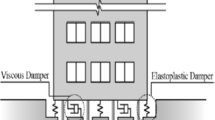Abstract
Considering that one of the most important issues in urban excavations is the interaction between excavation and adjacent buildings, it is always crucial to study the behavior of the excavation system and its adjacent structures. Today, many methods are used to protect the stability of the excavations and to provide desired safety. One of these various methods is brick stair wall, which is used in some projects due to its characteristics such as its cost-effectiveness and proper function. Therefore, in this paper, the effect of using this method as the excavation supporting structure on the stability of the excavation wall and its role in reducing the deformation created in the wall and the surrounding ground, using Fast Lagrangian Analysis of Continua (FLAC), is discussed. The results show that the amount of deformation parameters of excavation and adjacent building constantly increase as the excavation depth and building weight increase or soil density decreases. In addition, the numerical simulations indicates that applied surcharge on the adjacent area of the stair wall (caused by the adjacent building weight) has the main effect on the damage criteria.
Similar content being viewed by others
References
Boscardin, M. D. and Cording, E. J. (1989). “Building response to excavation–induced settlement.” Journal of Geotechnical Engineering, vol. 115, no. 1, pp. 1–21. DOI: 10.1061/(ASCE)0733–9410 (1989) 115:1(1).
Brinkgreve, R. B. J. and Vermeer, P. A. (1998). Plaxis manual, Vol. 7, Balkema.
Budhu, M. (2008). Foundations and earth retaining structures, John Wiley & Sons, Hoboken, NJ, USA.
Burland, J. B. (1995). “Assessment of risk of damage to buildings due to tunnelling and excavations.” Proc. 1st Int. Conf. Earthquake Geotechnical Engineering, IS, Tokyo, Japan, pp. 1189–1201.
Cai, W., McDowell, G. R., and Airey, G. D. (2014). “Discrete element visco–elastic modeling of a realistic graded asphalt mixture.” Soils and Foundations, vol. 54, no. 1, pp. 12–22. DOI: 10.1016/j.sandf. 2013.12.002.
Chen, C., McDowell, G. R., and Thom, N. H. (2014). “Investigating geogrid reinforced ballast: experimental pull–out tests and discrete element modeling.” Soils and Foundations, vol. 54, no. 1, pp. 1–11. DOI: 10.1016/j.sandf.2013.12.001.
Colas, A. S., Morel, J. C., and Garnier, D. (2010). “2D modelling of a dry joint masonry wall retaining a pulverulent backfill.” International Journal for Numerical and Analytical Methods in Geomechanics, vol. 34, no. 12, pp. 1237–1249. DOI: 10.1002/nag.855.
Cundall, P. A. (2001). FLAC manual: A computer program for Fast Lagrangian Analysis of Continua, Minneapolis, MN, USA.
Day, R. W. (1998). “Ground–movement related building damage.” Journal of Geotechnical and Geoenvironmental Engineering, vol. 124, no. 5, pp. 462–465. DOI: 10.1061/(ASCE)0733–9410(1996)122:11 (886).
Dewoolkar, M. M., Chan, A. H. C., Ko, H. Y., and Pak, R. Y. S. (2009). “Finite element simulations of seismic effects on retaining walls with liquefiable backfills.” International Journal for Numerical and Analytical Methods in Geomechanics, vol. 33, no. 6, pp. 791–816. DOI: 10.1002/nag.748.
Mathieu, N. J., Sab, K., and Zafimi, A. (2012). “An enhanced homogenization approach for masonry structures with compressible joints. Application to hearth thermomechanical computations.” Int. J. Numer. Anal. Methods Geomech, vol. 36, pp. 1102–1124. DOI: 10.1002/nag.1041.
Pandey, B. H. and Meguro, K. (2004). “Simulation of Brick masonry wall behavior under in plane lateral loading using applied element method.” 13 th World Conference on Earthquake Engineering, Canadian Association for Earthquake Engineering and International Association for Earthquake Engineering, Vancouver, BC, Canada, Vol. 1.
Prenay, M. (2014). Hedrowing and guard structures, Pyramid Publishing, Tehran, Iran.
Vermeltfoort, A., Raijimakers, T., and Jansen, H. (1993). “Shear test on masonry walls.” Proceedings of 6th North American Masonry Conference, The Masonry Society, Philadelphia, PA, USA, pp. 1183–1193.
Wang, J. and Yan, H. B. (2012). “DEM analysis of energy dissipation in crushable soils.” Soils Found, vol. 52, no. 4, pp. 644–657. DOI: 10.1016/j.sandf.2012.07.006.
Yamamoto, H., Nishigata, T., Yao, M., Nishida, K., and Kasa, H. (2010). “Study on the deformation characteristic of masonry walls during earthquake with full–sized model.” J. Jpn., Soc. Civ. Eng., vol. 66, no. 1, pp. 43–57. DOI: 10.2208/jscejc.66.43 (in Japanese).
Yoshida, J. (2005). “DEM analysis for direct shear test of granular assemblies.” Proc. Jpn. Geotech, Soc., vol. 40, pp. 1817–1832 (in Japanese).
Author information
Authors and Affiliations
Corresponding author
Rights and permissions
About this article
Cite this article
Beyzaei, M., Hosseininia, E.S. A Numerical Investigation on the Performance of the Brick Stair Wall as a Supporting Structure by Considering Adjacent Building. KSCE J Civ Eng 23, 1513–1521 (2019). https://doi.org/10.1007/s12205-019-1317-2
Received:
Revised:
Accepted:
Published:
Issue Date:
DOI: https://doi.org/10.1007/s12205-019-1317-2




